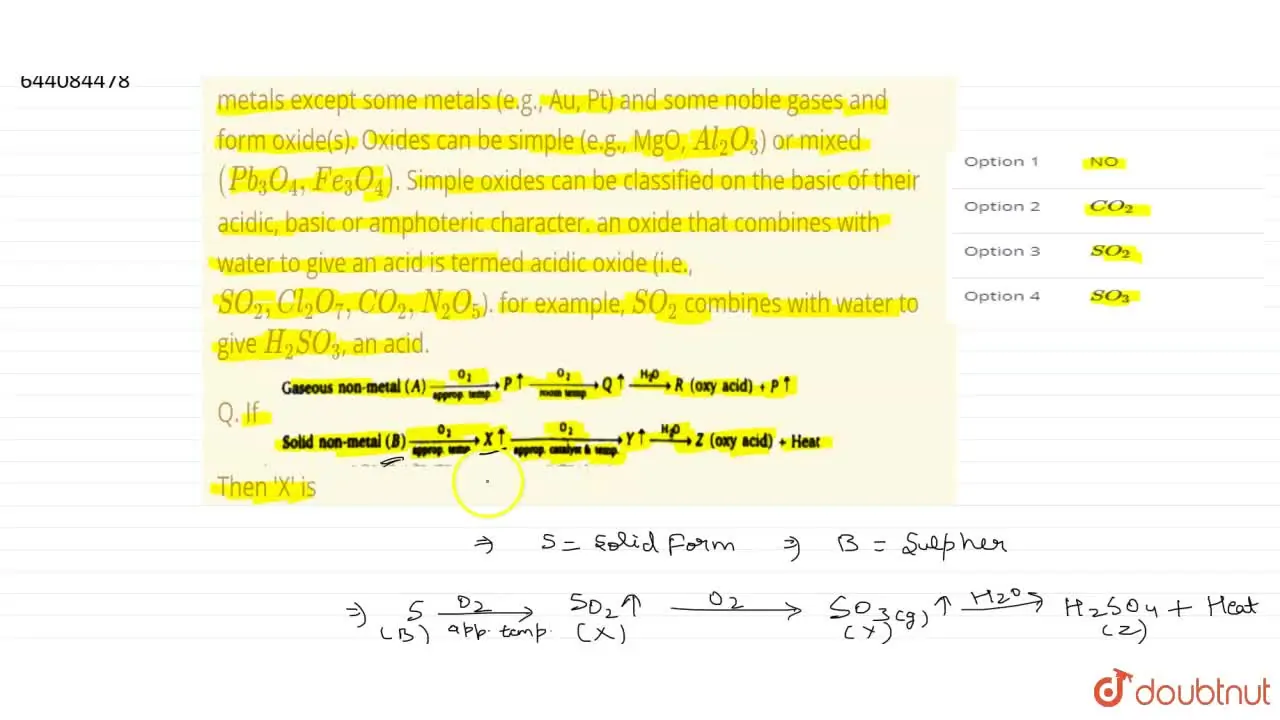Dioxygen directly reacts with nearly all metals annd non-metals except some metals (e.g., Au, Pt) and some noble gases and form oxide(s). Oxides can be simple (e.g., MgO, Al2O3) or mixed (Pb3O4,Fe3O4). Simple oxides can be classified on the basic of their acidic, basic or amphoteric character. an oxide that combines with water to give an acid is termed acidic oxide (i.e., SO2,Cl2O7,CO2,N2O5). for example, SO2 combines with water to give H2SO3, an acid.
Q. If 
Then 'X' is
NO
CO2
SO2
SO3
The correct Answer is:C
Step by step video & image solution for Dioxygen directly reacts with nearly all metals annd non-metals except some metals (e.g., Au, Pt) and some noble gases and form oxide(s). Oxides can be simple (e.g., MgO, Al_(2)O_(3)) or mixed (Pb_(3)O_(4),Fe_(3)O_(4)). Simple oxides can be classified on the basic of their acidic, basic or amphoteric character. an oxide that combines with water to give an acid is termed acidic oxide (i.e., SO_(2),Cl_(2)O_(7),CO_(2),N_(2)O_(5)). for example, SO_(2) combines with water to give H_(2)SO_(3), an acid. Q. If Then 'X' is by Chemistry experts to help you in doubts & scoring excellent marks in Class 12 exams.
Related Playlists
- BOOK - VK JAISWAL ENGLISHCHAPTER - TYPES OF REACTIONSEXERCISE - ONE OR MORE ANSWERS IS/ARE CORRECT40videos
TYPES OF REACTIONS
- BOOK - VK JAISWAL ENGLISHCHAPTER - TYPES OF REACTIONSEXERCISE - MATCH THE COLUMN14videos
TYPES OF REACTIONS
- BOOK - VK JAISWAL ENGLISHCHAPTER - TYPES OF REACTIONSEXERCISE - LEVEL 2196videos
TYPES OF REACTIONS
- BOOK - VK JAISWAL ENGLISHCHAPTER - s-BLOCK ELEMENTSEXERCISE - SUBJECTIVE PROBLEMS2videos
s-BLOCK ELEMENTS
Similar Questions
Dioxygen directly reacts with nearly all metals annd non-metals except some metals (e.g., Au, Pt) and some noble gases and form oxide(s). Oxides can be simple (e.g., MgO, Al2O3) or mixed (Pb3O4,Fe3O4). Simple oxides can be classified on the basic of their acidic, basic or amphoteric character. an oxide that combines with water to give an acid is termed acidic oxide (i.e., SO2,Cl2O7,CO2,N2O5). for example, SO2 combines with water to give H2SO3, an acid.
Q. If,

Then select incorrect statement with respect to gas 'X'View SolutionDioxygen directly reacts with nearly all metals annd non-metals except some metals (e.g., Au, Pt) and some noble gases and form oxide(s). Oxides can be simple (e.g., MgO, Al2O3) or mixed (Pb3O4,Fe3O4). Simple oxides can be classified on the basic of their acidic, basic or amphoteric character. an oxide that combines with water to give an acid is termed acidic oxide (i.e., SO2,Cl2O7,CO2,N2O5). for example, SO2 combines with water to give H2SO3, an acid.
Q. If,
Then select incorrect statement with respect to gas 'X'View SolutionDioxygen directly reacts with nearly all metals annd non-metals except some metals (e.g., Au, Pt) and some noble gases and form oxide(s). Oxides can be simple (e.g., MgO, Al2O3) or mixed (Pb3O4,Fe3O4). Simple oxides can be classified on the basic of their acidic, basic or amphoteric character. an oxide that combines with water to give an acid is termed acidic oxide (i.e., SO2,Cl2O7,CO2,N2O5). for example, SO2 combines with water to give H2SO3, an acid.
Q. If,
Then select correct statement with respect to gas 'Q'?View SolutionCalculate the oxidation number of nitrogen in the following oxides.
N2O,NO,N2O3,NO2,N2O5View SolutionWrite the oxyacids of the following oxides: N2O3,N2O5,N2O4
View SolutionWhich of the following is amphoteric oxide?
Mn2O7,CrO3,Cr2O3,CrO,V2O5,V2O4View SolutionArrange the following oxides in decreasing acidic order
SiO2 (I) CO2(II) SO3(III) N2O5(IV)View SolutionWhich of the following oxides are acidic ?
CuO,Mn2O7,CO,SO2,CrO3View SolutionWhich of the following compound is most acidic? Cl2O7, P4O10, SO3 B2O3
View SolutionWhich of the following compound is most acidic? Cl2O7, P4O10, SO3 B2O3
View Solution


